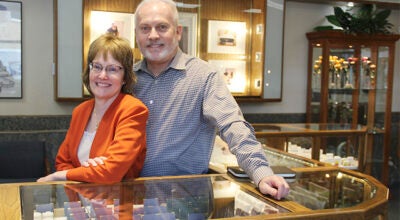Extra funding does little to increase dental care for Medical Assistance recipients
Published 8:55 am Friday, February 24, 2023

- Dental utensils in the dental clinic at Neighborhood Involvement Program in Minneapolis. Courtesy of Amanda Snyder
|
Getting your Trinity Audio player ready...
|
By Catharine Richert, Minnesota Public Radio News
Kim Sundve fostered 55 kids over a decade-and-a-half. Usually, when a child was put into her care, she tried to get them a dental appointment.
Often, it was their first.
“They’re going ‘My mouth hurts, I can’t chew, I can’t do this.’ And then we expect them to focus and do well in school and their mouth is just on fire,” she said.
But Sundve, who lives in Litchfield, Minn., said getting her foster kids in to see a dentist was hard. It’s because they’re on Medical Assistance — or Medicaid, as it’s more commonly known outside Minnesota — and don’t see a dentist regularly.
“You call and call and call and ask people if they have any new patients’ availability. And the answer often is ‘No.’”
On her husband’s employer’s insurance plan, Sundve can get in to see her dentist in a few days.
Vexing problem
Sundve’s situation highlights a long-standing and vexing problem for Minnesota: People on MA are more likely to be behind on their dental care but they have the hardest time seeing a dentist — care that’s tied to preventing other long-term health problems including cardiovascular issues.
In 2021, state legislators tried to fix the problem by nearly doubling the amount of money MA pays dentists for each appointment. They set goals for the number of visits MA enrollees should have annually.
Department of Human Services Deputy Assistant Commissioner Julie Marquardt said those changes came out of years of conversation with the state’s dental community.
“We wanted to work with [dentists] to really promote, ‘How can we ensure all Minnesotans can get dental care when we’re seeing these disparities with low income folks in their communities,’” she said.
But based on data from the state and from health insurance companies that manage most MA enrollees, the changes haven’t made much of a difference.
“We see that really as a start, not an ending point,” said Marquardt. “We know there’s more work to do.”
Famously low rates
Pictures of children with rotting teeth hang in DFL Rep. Tina Liebling’s offices at home in Rochester and at the State Capitol. She chairs the Health Finance and Policy Committee and said the pictures are a reminder that dental care shouldn’t only be for those who can afford it.
For years, low reimbursement rates were to blame for Minnesota’s notably low access to dental care for MA enrollees, Liebling said. Rates were based on decades old dental costs.
“Kind of famously, those rates are really low. Another complaint we would hear is that dentists weren’t even told what they would be paid until after they provided the service,” she said.
In 2021, Liebling and her colleagues ushered through higher MA reimbursement rates — a nearly 100 percent increase from what they had been. They also set goals for the health care plans that serve the vast majority of the state’s MA enrollees.
Among them: at least 55 percent of their MA participants would need to see the dentist once a year.
But more money hasn’t moved the needle.
State data provides a snapshot of the problem: In 53 counties, there are two or fewer dental clinics that accept MA enrollees managed by the state. After a year of higher reimbursement rates, about 2,200 dentists will see the state’s MA enrollees – only 46 more than before the state made changes.
It’s an intractable problem that exposes a host of challenges affecting health care access in general: labor shortages, transportation and geography are all at play, said Liebling.
“It is a problem with a lot of different components. It’s not just the money.”
Transportation, language barriers to care
In Olmsted County, Cathy Burns navigates this maze of roadblocks daily. She’s the county’s program manager for aging and care coordination, and her staff works with about 3,000 MA enrollees.
“We had hoped with the changes this past year that maybe we would see either more clinics pop up or more openings occur, or we would be able to have more success in getting individuals dental care,” she said. “But it still continues to be a challenge.”
There are still only two or three offices in her county that take MA patients consistently — not nearly enough to meet demand, said Burns. And even then, getting an appointment isn’t guaranteed; they’re often booked out for months.
MA enrollees may also struggle with other barriers to care – like needing a translator or lacking transportation, said Burns’ colleague Heather Robinson. The county provides services to overcome these barriers, but they aren’t foolproof.
“Say you need to ride to the dentist and you don’t have a car,” she said. “If you miss your appointment too many times in a row, you can’t go to that dentist again for a year.”
No-shows are a concern for private dentists, because they can’t make up for that lost revenue, said Owatonna dentist Tim Holland, who is also president of the Minnesota Dental Association.
“Things happen, we certainly understand that,” he said. “But if it’s a repeated issue, then we have to talk about that and address it and the potential that you might not be a patient here any longer is real, you know, and we don’t want that to happen.”
Meanwhile, Holland says a shortage of dental assistants and hygienists make it hard for private dentists to staff their offices to meet demand — a shortage made worse by the pandemic.
A financial lifeline
Labor shortages — especially among dental assistants and hygienists — are felt by clinics set up to serve people on MA, too, says Community Dental Care CEO Karen Kleinhans.
About 90 percent of Community Dental Care’s patients are on public programs, said Kleinhans, so demand for their services remains high around the state.
But higher reimbursement rates have helped the five clinics in her organization’s network stay afloat.
“It helped us just keep our doors open. The costs had been getting so high in terms of supplies, utilities, rent,” she said. “But what [the higher rates] have enabled us to do is also increase wages, which has been the other challenge for us.”
Kleinhans’ organization is part of a coalition asking the state to spend more on dental clinics that serve people on public programs, and to address labor shortages in the dental profession — for instance, helping community colleges create more spots for dental assistant and hygiene students.
‘A very hard dial to move’
Meanwhile, Minnesota’s health insurers are working to get more of their MA enrollees to the dentist. But meeting new state goals has been difficult, said Ghita Worcester, who is UCare’s Executive Vice President of Public Affairs and Chief growth officer.
In 2021, less than 40 percent of UCare’s MA population saw the dentist at least once. Worcester said that hasn’t changed much since higher reimbursement rates kicked in last year; UCare is still short of the Legislature’s goal of 55 percent.
UCare’s list of 1,300 dentists that serve MA enrollees hasn’t expanded much since those changes kicked in, either.
UCare reimburses its dentists more than what’s required by the state, Worcester said. But it’s still not on par with much higher commercial plan reimbursements.
The system as a whole deters dentists from participating, she said.
“If you can fill your practice with commercial members where the reimbursement is higher, or Medicare, or private pay, and how many slots do you give to the Medicaid population?”
UCare is trying to expand access in other ways. It deploys mobile dental clinics around the state. A hotline helps MA enrollees find appointments, transportation and translation services. Grants have helped clinics that see more MA patients hire additional staff.
“That’s a whole lot of initiatives to move the dial,” Worcester said. “And yet it’s a very hard dial to move.”
Back in Litchfield, Kim Sundve has retired from being a foster parent and now helps new foster families get settled. She recently was on the phone for more than two hours trying to help a family find dental care for their foster child.
It’s hard to introduce those new families to a system that’s stacked against them, she said.
“You want to give them everything that you would give your own child,” said Sundve. “And you’re just left high and dry, because you can’t help what the system has given them.”
Jennifer Lu and Curtis Gilbert contributed to this report.



